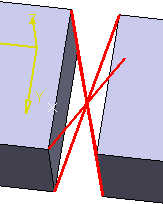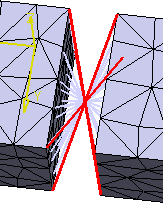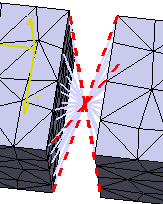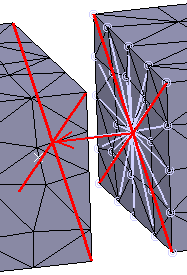In the Connection Property toolbar, click Connection Property Manager  .
.
The Connection Property Manager dialog box appears.
This dialog box lists:
- All the engineering connections created in the root product.
- For each engineering connection, all the connection properties applied to the engineering connection.
- The status of each connection property: included or excluded. If a connection property is included, the corresponding connection mesh exists and is stored under Nodes and Element. A connection property created in the Assembly Design workbench is ignored by default. A connection property created using the Connection Property Manager capability is included by default (you have to define parameters of the connection mesh).
Optional:
To filter the list of engineering connections, select a product in the specification tree or directly in the 3D viewer.
The displayed list is filtered. Only the engineering connections that are applied to the selected products are displayed in the Connection Property Manager dialog box.
Optional: To display the complete list of engineering connections, click Clear Selection.
To add a connection property to an engineering connection, right-click the engineering connection, select Add Property, and select one of the following:
The corresponding dialog box appears.
Define the property and click OK.
A symbol appears to represent the connection property.
Example for a rigid distant connection property:

If mesh information is needed (as a tolerance value, diameter of a spot weld...), a dedicated dialog box appears to define the parameters of the connection mesh.
Define the parameters of the connection mesh.
For face-face, fastened, and bolt tightening connection properties, you have to define a tolerance value. The tolerance is the distance between the two sets of geometries you connect.
- Enter a tolerance value in the Tolerance box.
- Click OK.
For weld connection properties:
- To create a compatible mesh, select Compatible.
A compatible mesh lets you use existing nodes. The welding point must have been previously projected. If you select Incompatible, the welding points are orthogonally projected on the two meshes to create nodes.
- Enter values to define the spot weld, the seam weld, the curve weld or the surface weld.
- Click OK.
To include a connection property into a simulation and to mesh it, right-click a line and select Include.
The Included status
of the connection property is set to Yes, a connection mesh appears in the specification tree under Nodes and Element, and a symbol representing the connection property appears in the 3D viewer.
To remove a connection mesh, right-click a line and select Exclude.
The Included status
of the connection property is set to No, the connection mesh disappears from the specification tree, and the symbol representing the connection property is hidden.
Optional: To delete a connection property applied to an engineering connection, select the line corresponding to the connection property in the list, right-click it and select Delete.
Click OK.
You have to update the mesh.

Examples of Connection Meshes
A rigid distant connection mesh is symbolized as shown below:

A smooth distant connection mesh is symbolized as shown below:

A user-defined connection mesh with the Spring-Smooth/Beam-Spring/Rigid combination is
symbolized as shown below:

![]()



